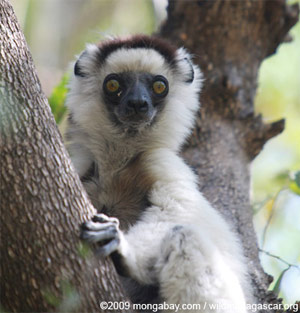Policy-makers designing a climate change mitigation mechanism that will reduce emissions from deforestation and degradation (REDD) aren’t doing enough to ensure that the scheme protects biodiversity outside carbon-dense ecosystems, argues an editorial published in Current Biology by a prominent group of scientists.
The fear is that REDD, which would pay countries for protecting forest carbon stocks, could bias conservation decisions away from ecologically-important ecosystems that are low in biomass or under high population pressure and therefore expensive to protect. These areas would then be at greater risk for conversion to agriculture or biofuel plantations as developers sought alternative lands for exploitation. Effectively REDD payments for tropical forest conservation could increase the cost of protecting non-tropical forest ecosystems.
 Will non-rainforest lemurs lose out under the UN REDD mechanism? |
“Concentrations of carbon density and biodiversity in tropical forests only partially overlap,” Alan Grainger, a researcher at the University of Leeds and lead author of the paper, said in a statement. “We are concerned that governments will focus on cutting deforestation in the most carbon-rich forests, only for clearance pressures to shift to other high biodiversity forests which are not given priority for protection because they are low in carbon.”
“If personnel and funds are switched from existing conservation areas they too could be at risk, and this would make matters even worse.”
By some estimates, up to 50% of tropical biodiversity hotspot areas could be excluded from REDD due to the high cost of protecting them, a product of both their low carbon density and increased land values resulting from development displaced from forest areas compensated under REDD. The authors also highlight the danger of transnational leakage, whereby deforestation reduced in one country—perhaps a REDD-signatory—is simply displaced to another—perhaps a non-REDD-signatory.
The authors conclude by proposing a series of actions at the upcoming UNFCCC in Copenhagen to ensure that biodiversity is protected under a future climate agreement.
The authors argue for the development of a separate payments-for-biodiversity system, made using non-carbon market financing, to counter this risk.
“This would mobilize the power of private carbon markets to pay for the emission reductions, yet discourage low-price, low biodiversity schemes,” the authors write. “Suitably combined payments for carbon and biodiversity could promote both simultaneously.”
CITATION: Alan Grainger et al (2009). Biodiversity and REDD at Copenhagen. Current Biology Vol 19 No 21
Related articles

(11/17/2009) Reducing Emissions from Deforestation and Degradation [REDD] programs that include landowners will conserve more habitat and ensure greater ecosystem services function than programs that focus solely on protected areas, report researchers from the Woods Hole Research Center (WHRC), the Instituto de Pesquisa Ambiental da Amazônia (IPAM), and the Universidade Federal de Minas Gerais (UFMG).
REDD shouldn’t neglect biodiversity say scientists
(07/30/2009) Schemes to mitigate climate change by protecting tropical forests must take into account biodiversity conservation, said two leading scientific organizations at the conclusion of a four day meeting in Marburg, Germany.
REDD could trigger bias in conservation funding towards carbon-rich ecosystems
(06/12/2008) The Reducing Emissions from Deforestation and Degradation (REDD) mechanism proposed as a means to fight global warming and protect forests may leave some ecosystems at risk to development argue researchers in an editorial published in the journal Science.














